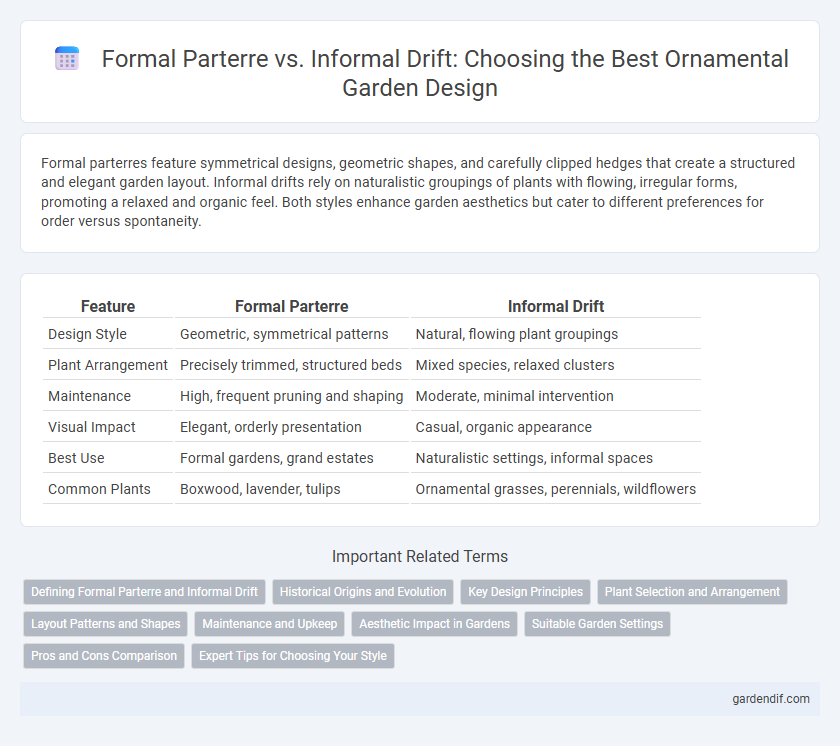
Formal Parterre vs Informal Drift Illustration
Formal parterres feature symmetrical designs, geometric shapes, and carefully clipped hedges that create a structured and elegant garden layout. Informal drifts rely on naturalistic groupings of plants with flowing, irregular forms, promoting a relaxed and organic feel. Both styles enhance garden aesthetics but cater to different preferences for order versus spontaneity.
Table of Comparison
| Feature | Formal Parterre | Informal Drift |
|---|---|---|
| Design Style | Geometric, symmetrical patterns | Natural, flowing plant groupings |
| Plant Arrangement | Precisely trimmed, structured beds | Mixed species, relaxed clusters |
| Maintenance | High, frequent pruning and shaping | Moderate, minimal intervention |
| Visual Impact | Elegant, orderly presentation | Casual, organic appearance |
| Best Use | Formal gardens, grand estates | Naturalistic settings, informal spaces |
| Common Plants | Boxwood, lavender, tulips | Ornamental grasses, perennials, wildflowers |
Defining Formal Parterre and Informal Drift
Formal Parterre is a meticulously designed garden layout characterized by symmetrical patterns, geometric shapes, and neatly trimmed hedges that create structured, ornamental beds often filled with colorful flowering plants. Informal Drift, in contrast, features a more naturalistic approach with loosely arranged clusters of plants, emphasizing organic flow and softer edges without strict symmetry. These distinct styles cater to different aesthetic preferences, with Formal Parterre highlighting order and precision while Informal Drift embraces a relaxed, spontaneous garden atmosphere.
Historical Origins and Evolution
Formal parterres originated in the Renaissance gardens of Europe, characterized by symmetrical patterns and meticulously trimmed hedges designed to display order and control over nature. Informal drifts evolved during the English Landscape Movement of the 18th century, favoring naturalistic groupings of plants that mimic wild growth and provide a softer, more relaxed aesthetic. Both styles reflect shifting cultural values, with parterres emphasizing formality and power, while drifts highlight natural beauty and romanticism.
Key Design Principles
Formal parterres emphasize symmetry, geometric shapes, and meticulously clipped hedges to create structured, precise patterns that guide the viewer's eye. Informal drifts rely on naturalistic groupings, flowing lines, and varied plant heights to mimic organic growth and provide a relaxed, dynamic aesthetic. Key design principles highlight order and control in formal parterres, contrasting with spontaneity and softness in informal drifts.
Plant Selection and Arrangement
Formal parterres feature symmetrical plant selection with structured geometric patterns, using low-growing, evergreen shrubs and flowering plants like boxwood and lavender to create precise borders. Informal drifts utilize a more relaxed arrangement with a variety of perennials and grasses, emphasizing naturalistic grouping and seasonal color changes. Plant choices in informal drifts prioritize texture and color diversity, while formal parterres focus on uniformity and repetition.
Layout Patterns and Shapes
Formal parterre gardens feature symmetrical, geometric layout patterns with precisely clipped hedges forming intricate shapes such as squares, circles, and diamonds, emphasizing order and balance. Informal drift designs use free-flowing, asymmetrical shapes that mimic natural growth, creating a relaxed, organic feel with curving lines and irregular planting masses. The contrast lies in the structured rigidity of formal parterres versus the fluid, naturalistic arrangement of informal drifts.
Maintenance and Upkeep
Formal parterres require meticulous maintenance, including precise trimming, weeding, and regular pruning to preserve their symmetrical patterns and defined edges. Informal drifts demand less frequent upkeep but need careful attention to plant health and seasonal replanting for a naturalistic appearance. Both styles benefit from soil conditioning and pest control tailored to their unique structural and aesthetic requirements.
Aesthetic Impact in Gardens
Formal Parterres create a symmetrical and structured aesthetic with precise geometric patterns and neatly clipped hedges, enhancing visual order and elegance in gardens. Informal Drifts introduce naturalistic, flowing groupings of plants that emphasize organic shapes and seasonal variety, offering a relaxed and dynamic visual appeal. The contrast between the rigid formality of parterres and the freeform nature of drifts significantly influences the garden's overall atmosphere and style.
Suitable Garden Settings
Formal parterres suit structured garden settings with symmetrical layouts, often found in classical or French-style gardens emphasizing precision and order. Informal drifts are ideal for naturalistic or cottage gardens, where flowing plant groupings create relaxed, organic aesthetics. Choosing between these styles depends on whether the garden emphasizes geometric control or casual, seasonal variety.
Pros and Cons Comparison
Formal parterres offer precise geometric patterns and manicured symmetry, creating an elegant and structured ornamental garden ideal for showcasing topiary and seasonal bedding plants. Informal drifts provide a relaxed, naturalistic planting style with flowing masses of perennials and grasses, promoting biodiversity and effortless seasonal interest but requiring more maintenance to prevent overgrowth. While formal parterres demand regular pruning and upkeep to maintain their crisp lines, informal drifts allow for adaptability in plant selection but may lack the visual impact of a meticulously designed parterre.
Expert Tips for Choosing Your Style
Formal parterres emphasize symmetry, precise geometric shapes, and neatly trimmed hedges, creating a structured and elegant garden layout. Informal drifts prioritize naturalistic planting with flowing lines and varied plant textures, fostering a relaxed, organic feel ideal for cottage or wild gardens. Experts advise assessing your space, maintenance capacity, and personal aesthetic to select a style that complements your home's architecture and lifestyle.
Formal Parterre vs Informal Drift Infographic

 gardendif.com
gardendif.com